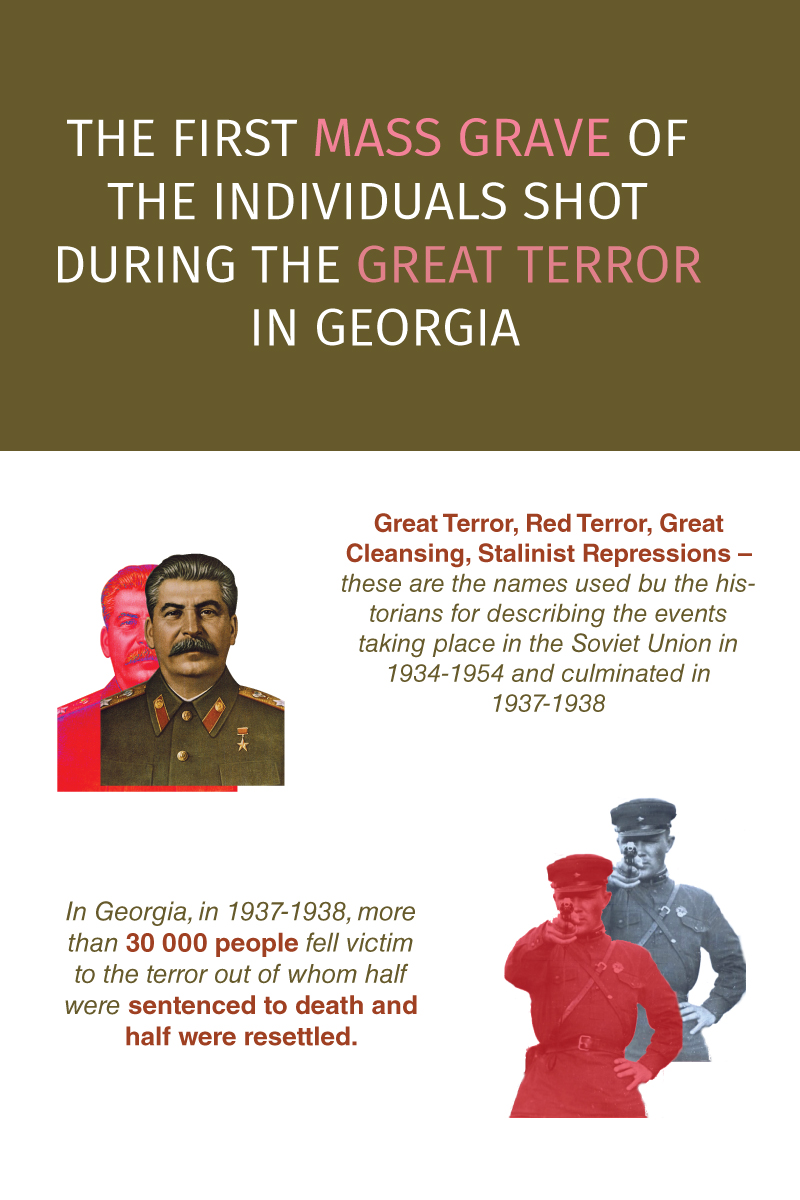 A year has passed since the Batumi and Lazeti Diocese discovered a burial site of around 150 persons in Khelvachauri, near the city of Batumi. Although, in the beginning, there was an opinion among researchers that the mass grave might not be of the repressed individuals at all, and it could have been the burial site of Turkish soldiers, the items discovered at the site – the Soviet coins of the 1930s, bullets and a cross prove that these graves belong not to the Turkish soldiers but to the Soviet citizens, among which were the Christians. This claim is also supported by the fact that the discovered bodies had their hands tied behind their back and the penetrating wounds were identified on their skulls that were similar to the wounds of the victims of the Soviet repressions discovered in the other countries. While waiting for the government’s decision, after the appropriate actions would have been taken, following the separation of the bodies, the Diocese of Batumi and Lazeti ordered the preparation of the wooden coffins in which the bodies were placed and these coffins were located on the lower ground floor of Holy Mother Virgins Nativity Cathedral in Batumi.
A year has passed since the Batumi and Lazeti Diocese discovered a burial site of around 150 persons in Khelvachauri, near the city of Batumi. Although, in the beginning, there was an opinion among researchers that the mass grave might not be of the repressed individuals at all, and it could have been the burial site of Turkish soldiers, the items discovered at the site – the Soviet coins of the 1930s, bullets and a cross prove that these graves belong not to the Turkish soldiers but to the Soviet citizens, among which were the Christians. This claim is also supported by the fact that the discovered bodies had their hands tied behind their back and the penetrating wounds were identified on their skulls that were similar to the wounds of the victims of the Soviet repressions discovered in the other countries. While waiting for the government’s decision, after the appropriate actions would have been taken, following the separation of the bodies, the Diocese of Batumi and Lazeti ordered the preparation of the wooden coffins in which the bodies were placed and these coffins were located on the lower ground floor of Holy Mother Virgins Nativity Cathedral in Batumi.
The discovery of the mass graves is very important event for Georgia. In general, the studies of the stories of the repressed persons, their proper commemoration and immortalization is an important and urgent issue in the post-Soviet region. In many countries, on the execution and burial sites, there are complexes of memorials and the governments support the commemoration of the repressed, educational and the other types of events. All of these have a key role in the formation of collective memory of the countries and the rethinking of the totalitarian past. The graves discovered in Khelvachauri is the first discovery of this kind in Georgia, which requires an appropriate attention from the state.
At the initial stage, particular steps were taken by the government, which facilitated an expectation that the state would pay appropriate attention to this issue - after the spread of the information by the Diocese, the Government of Adjara created the special commission at the Ministry of Health of Adjara which was obliged to study the issue, work on the identification of the remains, the organization of burial and the arrangement of the memorial; Levan Samkharauli National Forensics Bureau took DNA from the remains and created the relevant database; for the studies of the newly-discovered graves, the Ministry of Education, Culture and Sport of Adjara was requested to create a special task force; for the discovery and studies of the graves at the location indicated above, situational sketch was created and the information regarding the territorial security was requested from the Ministry of Defense of Georgia. However, soon, the state interest and attention toward this issue decreased and there is no significant progress in this direction. During 9-10 months after the discovery of the tombs, until the main concern of the whole country has become the fight against Coronavirus, no progress was achieved in this direction.
IDFI has been actively involved in the search for archival documents about the people repressed in Batumi and Adjara since the beginning. Through the archival research carried out by the organization, it has been established that between 1937-1938, through the various means of punishments totally 1050 were executed in Adjara, out of whom there were 11 women as well as Orthodox and Muslim religious figures. The women’s issue is very important because if the remains of any of them will be identified, it will be possible to establish when the people in different graves were shot dead. Also, it is essential the number of the minutes of the executions carried out at different times preserved at the MIA Archives to be compared with the number of bodies discovered in the graves because, as a rule, dozens of people were being executed simultaneously, and in case of the coincidence of numbers, the identification will simplify. IDFI gave this list to the representatives of Diocese of Batumi and Lazeti.
Due to the importance of the issue, on 19 September 2019, IDFI sent a letter to the Government of Adjara and called for taking rapid and effective measures toward studying the remains and burying and commemorating the victims of the Soviet repressions. However, until today, after a year of the discovery, the graves remain under researched, the preparation for the erection of the memorial at the place has not started and the educational or the other types of activities have not been initiated.
Moreover, IDFI started providing its international partners with the information about the burial sites discovered in Georgia. In November 2019, the Executive and Programs Director of IDIFI, Giorgi Kldiashvili and the Head of Archives, Soviet and Memory Studies Direction, Anton Vacharadze made a presentation about the graves in Khelvachauri at the conference organized by the organization International Memorial, which attracted a huge interest from the researchers attending the event.
IDFI still considers that he actions taken by the commission until now toward studying the graves and commemorating the victims are not enough and restates the recommendations for the Government of Adjara, that were issued a year ago:
- The Government of Adjara should assign a separate budget for the studies of the burial site of the repressed people near Batumi in 1937-1938, their commemoration and the identification of the remains.
- A special group of archaeologists and specialists should be created which will be working on already discovered graveyards and will continue looking for new sites of burials.
- The territory where the graves were found should be transferred to the Mayor’s Office of Batumi from the Ministry of Defense and the memorial complex of the victims of the Soviet repressions should be set there.
- An active campaign should be carried out for the identification of the remains which would encourage the descendants of the repressed people to provide their DNA which will be compared to the samples taken from the remains. The list created by IDFI reveals that during the repressions, dozens of people were executed simultaneously and they were placed into the same grave together (only five such graves have been found until now). If even a few bodies are identified, it will be possible to define certainly when the people in these graves were executed.
- Campaigns for raising public awareness especially among the school and university students should be held and the government, clergy and specialists should be involved in this process in order to spread the information about the Stalinist terror in 1937-1938.
- The agreement should be reached between the Orthodox Church of Georgia, and the Supreme Religious Administration of Georgia's All Muslims and the state should also be involved in it.
___

Publication of this article was financed by the Open Society Institute Budapest Foundation (OSI) within the frame of the project - Enhancing Openness of State Archives in Former Soviet Republics and Eastern Bloc Countries. The opinions expressed in this document belong to the Institute for Development of Freedom of Information (IDFI) and do not reflect the positions of Open Society Institute Budapest Foundation (OSI). Therefore, OSI is not responsible for the content.






